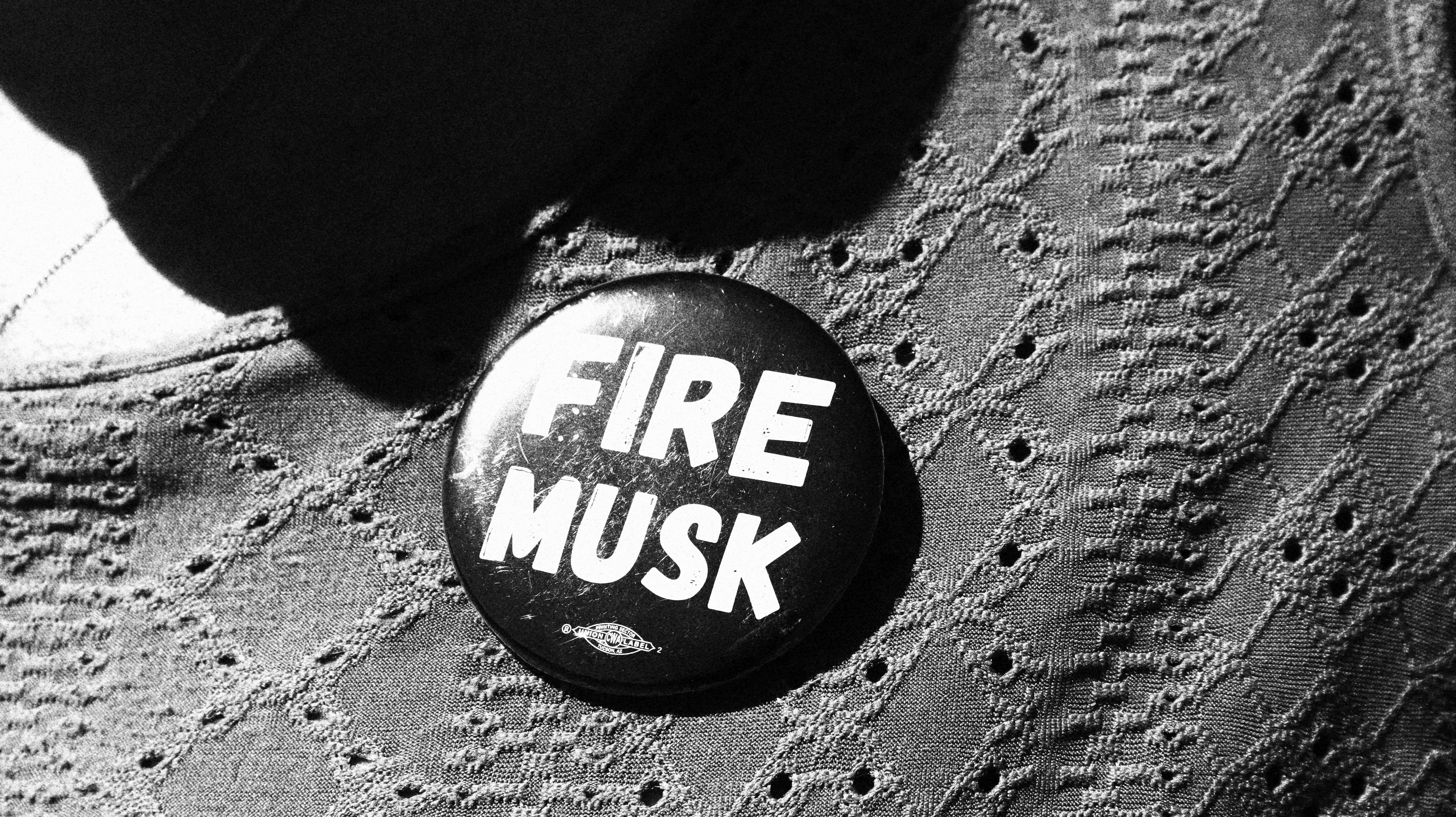As he waited in the shadow of a parking garage in Tempe, Arizona, to hear Sen. Bernie Sanders and Rep. Alexandria Ocasio-Cortez speak last Thursday evening, John Ward, a longtime Democrat from the deep-red retirement community of Sun City West, told me he “probably” hadn’t voted for the Independent Vermont senator in the past, but it felt like Sanders had become a party leader by default.
“I mean, Kamala [Harris] is not talking, Barack [Obama]’s not talking, [Joe] Biden’s not talking,” he said. “Right now, he’s the only one talking, and he’s the only one making sense.”
Ward arrived hours early to catch Sanders at the latest stop on his Fighting Oligarchy tour, but already, the line snaked around the block to get into the hockey arena on the campus of Arizona State University. The rallies, which Sanders began organizing in February to apply pressure to Republican lawmakers in their home districts, have been growing and growing. According to organizers, nearly 87,000 people attended five events last week—a stunning showing 20 months away from the midterm elections. Before an event at a high school football stadium in Tucson on Saturday—where people started arriving at 6 a.m. for an 11:30 start—I met a high school student who had persuaded her grandmother to come with her all the way from Redlands, California. It had taken them half a day, stopping every three hours to recharge their car. (No, they clarified, it was not that kind of electric car.)
The Fighting Oligarchy tour is drawing larger crowds than the Sanders presidential campaign ever did, but it’s also drawing a different sort of crowd. Although there were still more “Feel the Bern” T-shirts than you could count, at two stops in Arizona last week, most of the people I talked to were, like Ward, not longtime supporters. A significant number had not attended a political event or a protest before. Many of these voters found Sanders’ long-running message of a growing oligarchy newly resonant at a time when the richest man in the world has been given carte blanche to dismantle public institutions. Above all, they showed up because they wanted to hear elected officials express the sort of frustration and rage Democratic voters have been feeling for months. They wanted to be where the fight was. Sanders’ rallies offer both a lifeline and a warning to a party that hasn’t yet found its footing: Start going after President Donald Trump—or voters might start going after you, too.

You couldn’t go far at these rallies without running into someone who was dealing firsthand with the fallout from Trump and Elon Musk’s attack on the federal bureaucracy. The first person I talked to before Thursday’s rally in Tempe told me that he was moving back to Puerto Rico after being fired from the IRS. In Tucson on Saturday, I met an educator from a border community whose special education programming was getting wiped out due to cuts at the Department of Education. Sitting in the top row of bleachers at the event, a woman from Nogales whose company buys produce from Mexico spent five minutes patiently explaining the process of importing fruit and how the impending tariffs will force distributors to shut down.
For seniors, Social Security was top of mind. When I talked to Lisa Melton outside the arena in Tempe, she said she was now planning to tap into the program a year early and taking an annual $2,000 hit because she didn’t trust what the Trump administration was going to do to it. I don’t know if that’s a sound strategy; I do know that she was terrified.
“I tried to sign up for Social Security about a month ago,” said Therese Wagner, a bit further up the line. “I got in and then got error messages and I thought, Elon Musk is fucking with our Social Security already.”
Wagner eventually managed to apply, but rallygoers feared that things were only going to get worse. A retired bus driver named Kevin James volunteered that he’d recently gotten so upset after trying to talk to a human at the Social Security Administration that he called the White House right after.
“I politely said, ‘I would like to express concern and displeasure,’” he said. “Click.”
These people are as furious at Republicans right now, as you might expect. Musk would probably find a warmer reception on Mars. But what separates the energy of the Sanders-led Fighting Oligarchy tour from the 2017-era Resistance is that a lot of the anger is trained at their own party. Democratic voters’ approval of congressional Democrats has fallen 35 points since last year, according to a recent survey, and rallygoers at the two Arizona stops took aim at what they perceived as a toothless approach to the new administration.
“We have to take matters into our own hands, because the people who should be fighting for us aren’t.”
As she waited in the stands in Tucson on Saturday morning, Samantha Schrieber offered a characteristic response when I asked about what Democratic leaders have been doing.
“They’ve been doing something? What have they been doing?” she said. Then she laughed. “They haven’t been doing shit.”
Attendees at the Arizona rallies were the focus group of Sen. Chuck Schumer’s nightmares. They talked about “backbone” about as often as they talked about “fascism.” The strategy seemed to be to “play dead and just wait for everyone to vote for them,” one young voter complained. The Senate minority leader was “bringing a pillow to a gunfight,” said a cannabis worker. Watching the party fold over the federal budget was “incapacitating,” said a disabled veteran, who said he was thinking of running for office now himself. A woman who had just protested outside her Republican congressman’s office told me simply: “We have to take matters into our own hands, because the people who should be fighting for us aren’t.”
To a lot of the people I spoke with, too many Democrats were still searching for comity in a political climate that had moved beyond it.
“Democrats kind of lean on, like, a ‘they’re not all bad, we can all get along’ kind of thing,” said Adonis Gonzalez, who was selling “Deport Elon” and “Smash the Oligarchy” buttons outside the hockey arena. “I feel like right now, we don’t necessarily need that message. I think we need a message of, ‘Hey, there are bad people trying to do bad things and we should as good people come together and stop them.’”


The speakers on stage during the tour sought to channel this frustration into immediate action and longer-term transformation. Sanders, who has said he went on tour only after seeing the tepid response to Trump from the Democratic Party, chose his rally locations strategically. They are all either in competitive but Republican-held House districts or close to them. In Michigan earlier this month, he targeted second-term Rep. John James. In Colorado on Friday, it was first-term Rep. Gabe Evans. In Arizona, Ocasio-Cortez promised that Democrats would unseat veteran Republican Rep. David Schweikert, who held on to his suburban Phoenix seat in November in one of the country’s closest races. The hope is that with sustained public pressure on vulnerable Republicans, Democrats can convince enough of them to block Trump’s objectives in a narrowly divided chamber.
“Trump helped me immensely in educating the American people to what oligarchy is.”
Sanders is, in large part, still giving the speech about oligarchy that he’s been giving for the last decade. But the 83-year-old was a bit more soulful as he spoke with urgency about threats that are now not just theoretical, but existential. There were nods to both the nation’s founders and its second founding at the end of the Civil War—at various stops on the tour, he and the crowd have recited a portion of the Gettysburg Address together. It’s like a Tea Party rally for people who believe the 14th Amendment is real.
“From the bottom of my heart, I am still convinced that they can be defeated,” Sanders said on stage in Tempe.
Part of the reason for that optimism was the presence of a handful of considerably younger allies joining him on tour, including Texas Rep. Greg Casar and Ocasio-Cortez, who told the crowd in Tempe, “We’re gonna throw these bums out and fight for the nation we deserve,” before she even introduced herself.
And “these bums” might not all be Republicans. The Bronx Democrat, who as Sanders noted won her seat after beating a member of the Democratic leadership in a primary, drew huge applause when she told the crowd, “You all have shown that if a US senator isn’t fighting hard enough for you, you’re not afraid to replace her with one who will”—a reference to both Arizona Republican Martha McSally and the Democrat-turned-Independent Kyrsten Sinema, who declined to run for reelection in the face of plummeting Democratic support.
Musk and Trump—Vice President JD Vance was never mentioned—are trying “steal our health care, Social Security, and veterans benefits in order to pay for their tax cuts,” Ocasio-Cortez said. Pugilism was the name of the game. “We’re gonna fight, fight, fight,” she said. Attendees deserved people “with the courage to brawl for the working class.” In Tempe, she used the word “fight” 13 times.
“My queen!” someone at Arizona State shouted.
Ocasio-Cortez laughed. “Your representative,” she said.
Technically, the congresswoman from the Bronx isn’t that, either. (In fact, she was full of praise for the four Democrats currently representing Arizona in Washington.) But on stage, Ocasio-Cortez and her allies were holding themselves up as, in effect, the true opposition—an alternative power center that will stand up for working people when the people who promised to do so fade away.
After their speeches in Tucson had wrapped up Saturday and the announced crowd of 20,000 had begun to trickle out, Sanders and Casar chatted with reporters for a few minutes in the high school gym where the rally was originally slated to be held—before the surge in interest pushed it outdoors. It had been a hectic three-state tour, and Sanders had spoken for half an hour under a scorching high-desert sun. As he dropped into a folding chair, the senator looked spent. But he let out a loud laugh when I asked if it felt like people were more attuned to his message about oligarchy now, in Trump’s second term.
“Trump helped me immensely in educating the American people to what oligarchy is,” he said.
The inauguration crystallized things, he said. The three richest men in the world, sitting alongside the richest Cabinet in history, made for a powerful symbol. “It doesn’t take Bernie Sanders to point out that you now have a government of the billionaires, by the billionaires, and for the billionaires—I think that’s clear and apparent to everyone.”
Now that people have come around to Sanders’ diagnosis of the problem, he hopes they will accept the prescriptions he and his allies are offering. Anyone who has been listening to him for a while will recognize the applause lines—free health care, free college, new organizing protections for unions. He’s recently started using Musk’s obsession with artificial intelligence and automation at the Department of Government Efficiency to argue in his speeches that what’s happening to federal workers now will come for your industry, too—if it hasn’t already. But a major part of his pitch is the need to overhaul the Democratic Party. I asked Sanders what he thought about the rumblings about a liberal Tea Party.
While he commended the party’s accomplishments on social issues and civil rights, he reiterated a point he’s made in the past. “I think very few people who understand politics can deny that, by and large, for the last 30, 40 years, the Democratic Party has turned its back on the working class of this country, and that is the working class out there,” Sanders said, referring to the crowd outside. “They want leadership like Greg and Alexandria to stand up, and they want more people. They’re tired of Democratic hacks. They’re tired of Republicans.”
“I mean, we are taking on everybody,” he continued. “Taking on the oligarchy, taking on the Republican Party, taking on the Democratic leadership, taking on the corporate media, taking on Wall Street. It ain’t easy, and this change is not gonna happen overnight.”
Casar, chairman of the Congressional Progressive Caucus, put the point a bit more sharply, when I asked why it seemed like his colleagues had been caught flat-footed.
“The biggest divide right now within the Democratic Party [is] between fighters and folders—it’s not just between the sort of the typical left/right constellation that you usually talk about in political media.”
Democrats who rolled over in this moment were “playing some sort of political game,” he said, but “most people don’t think of their lives as a political game. They think of their lives as their only life on earth, and they want somebody to say, ‘We’re going to do everything we can to protect our democracy and keep your life from getting worse.’”
“We either have to listen to our voters, channel that energy, and turn this into an organizing moment,” he said, “or, you know, face the consequences from our voters.”
Sanders and his younger colleagues are hoping to channel this dissatisfaction into a movement that can remake the Democratic Party and wrest power back from the billionaire class. But a public uprising powered to such a large extent by the anger and anxieties of mainstream Democrats could still end up in a much different direction.
By the time we wrapped up in the gym in Tucson, the crowd had emptied out, and only a few stragglers remained. Lois Bursuk, a school psychologist, and Linda Laraia, a retired VA nurse, were cooling off under a tree by the main entrance. They said they were fed up with what they were seeing in Washington and had each taken their own steps to resist Trump. Bursuk recently had joined hundreds of protesters outside the nearby office of Republican Rep. Juan Ciscomani.
“They just inspire me to keep going, because they’ve been on this platform now for a decade, and I’m grateful that they’re there,” she said of Sanders and his colleagues.
But Laraia, when asked, offered a far different choice for a Democratic champion going forward.
“Okay, I’m gonna put in a plug for somebody I want to run for president,” she said. “Mark Cuban.”
Additional reporting by Nadia Hamdan and Sam Van Pykeren.

















